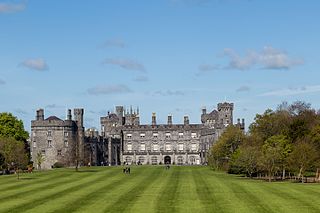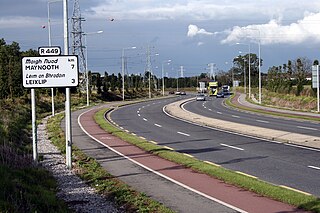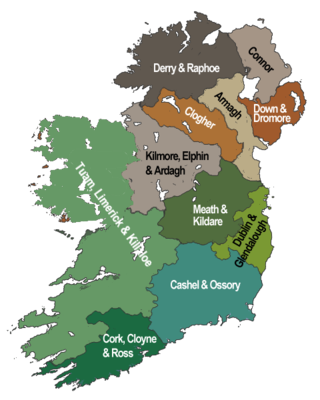External links
- Irish Architecture Online - comprehensive photo and data on buildings throughout Ireland
- Dataset comprising photographic documentation of 444 buildings in Dublin, Ireland. A UCD Digital Library Collection.
List of notable Irish buildings includes buildings in Ireland that are currently in-use which are landmarks of historical, cultural or governmental significance. For ruins, see National monuments of Ireland.

Kilkenny is a city in County Kilkenny, Ireland. It is located in the South-East Region and in the province of Leinster. It is built on both banks of the River Nore. The 2022 census gave the population of Kilkenny as 27,184, the thirteenth-largest urban center in Ireland.
Licensed radio broadcasting in Ireland is one element of the wider media of Ireland, with 85% of the population listening to a licensed radio broadcasting service on any given day.
The architecture of Ireland is one of the most visible features in the Irish countryside – with remains from all eras since the Stone Age abounding. Ireland is famous for its ruined and intact Norman and Anglo-Irish castles, small whitewashed thatched cottages and Georgian urban buildings. What are unaccountably somewhat less famous are the still complete Palladian and Rococo country houses which can be favourably compared to anything similar in northern Europe, and the country's many Gothic and neo-Gothic cathedrals and buildings.

A regional road in the Republic of Ireland is a class of road not forming a major route, but nevertheless forming a link in the national route network. There are over 11,600 kilometres of regional roads. Regional roads are numbered with three-digit route numbers, prefixed by "R". The equivalent road category in Northern Ireland are B roads.

The Liberties is an area in central Dublin, Ireland, located in the southwest of the inner city. Formed from various areas of special manorial jurisdiction, separate from the main city government, it is one of Dublin's most historic working class neighbourhoods. The area was traditionally associated with the River Poddle, market traders and local family-owned businesses, as well as the Guinness brewery, whiskey distilling, and, historically, the textiles industry and tenement housing.
A registration district in the United Kingdom is a type of administrative region which exists for the purpose of civil registration of births, marriages, and deaths and civil partnerships. It has also been used as the basis for the collation of census information.

The United Provinces of Dublin and Cashel, commonly called the Province of Dublin, and also known as the Southern Province, is one of the two ecclesiastical provinces that together form the Church of Ireland; the other is the Province of Armagh. The province has existed since 1833 when the ancient Province of Dublin was merged with the Province of Cashel. Its metropolitan bishop is the Archbishop of Dublin.

Francis Johnston was an Anglo/Irish architect, best known for building the General Post Office (GPO) on O'Connell Street, Dublin.
Féile na nGael is an annual tournament comprising the sports of hurling, camogie and handball organised by the Gaelic Athletic Association. Its stated aim is to bond communities, forge friendships, provide educational opportunities and unearth new leaders.
This is a list of coats of arms of Ireland. In the majority of cases these are arms assigned to county councils created by the Local Government (Ireland) Act 1898 or later legislation, either by the Chief Herald of Ireland in what is now the Republic of Ireland or by the College of Arms in Northern Ireland. All but two county councils in the Republic have a coat of arms. In Northern Ireland, county councils were abolished in 1973, but the traditional arms are still occasionally used.
The 2012 National Hurling League commenced in February 2012. 34 GAA county hurling teams: 32 from Ireland, London and Warwickshire, contested it.
The 2013 National Hurling League commenced in February 2013. 34 GAA county hurling teams: 32 from Ireland, London and Warwickshire, contested it.
The 2005 All-Ireland Minor Football Championship was the 74th staging of the All-Ireland Minor Football Championship, the Gaelic Athletic Association's premier inter-county Gaelic football tournament for boys under the age of 18.

William Percival "Percy" Le Clerc was Inspector of National Monuments in Ireland from 1949 to 1974, making him responsible for the preservation of buildings already classified as National Monuments. He also made decisions on which further buildings in Ireland should be brought into state ownership or guardianship. He was a founding member of the Irish Georgian Society.